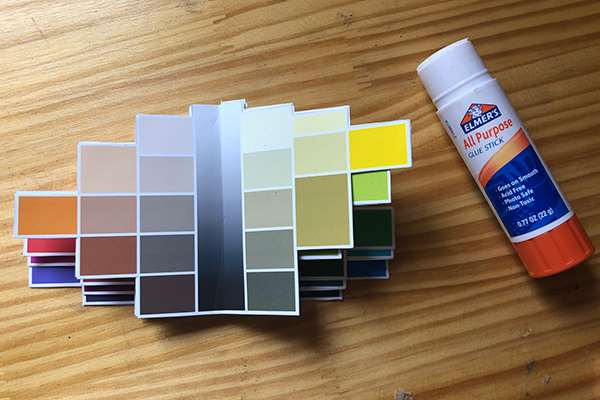Lightness Chroma Model
DESCRIBING COLOURS:
Colour Lightness/value and Chroma
Relate colour characters to Lightness and Chroma
Details:
Ages: Middle school or 11 years old and up*
Time: 30 minutes
Learning Outcomes:
Build a 3-D colour model which is organized by Lightness-chroma, and describe how the colours are arranged.
Compare the 3-D colour model organized by Lightness-chroma, with the Hue-plane colour model.
Colour Concepts: Recognize that 3-D colour models are not unique; the way colours can be represented and organized is “elastic”.
*Younger students may have trouble building the model but will find this a useful way to visualize hue families and characters. Teachers can build the model, and have it in the classroom for younger students.
Supplies:
Scissors, glue stick
Optional - metal ruler, metal stylus, bone folder
CLP Handout - CHROMO Lightness/Chroma Model
Instructions:
Figure 1. Supplies for building model.
Print out the three pages of the Chroma Handout in colour. (See Figure 1).
The basic supplies needed are scissors and a glue stick.
Metal stylus and ruler to score the center lines and a bone folder for pressing folds.
Directions for building Lightness Chroma Model:
Step 1. Due to the asymmetrical shapes, it helps to score a line between the top and bottom marks on the handout using the metal ruler and stylus.
Step 2: Cut out all the shapes and match in pairs as shown. The Orange/Yellow shape will not have a match.
Step 3: Fold each shape in half. Combine the pairs with the matching colour pointed up. Use a glue stick to glue the matching colour of each pair together. Arrange the glued pairs as shown.
Step 4a: Glue the two pairs together that share a Magenta hue
Step 4b: Glue the two pairs together that share a Green hue .
Step 5: Arrange the glued sets as shown.
Step 6a: Glue the two pairs together that share a Magenta hue
Step 6b: Glue the two pairs together that share a Green hue .
Step 7. Glue together the sets that share a Blue hue.
Step 8a: Glue the Orange sides together.
Step 8b: Glue the Yellow sides together.
Completed Lightness-chroma model.
Vocabulary:
Questions & Observations:
How does this Lightness-chroma model differ from the Hue-planes model?
How are the two models the same?
Why are the two models different?
How can you use colour models to understand colour relationships and attributes?
In which hue plane(s) do you find pinks?
In which hue plane(s) do you find browns?
What’s going on?
It is important to recognize that there is more than one way to organize colours. Although different colour models use different organizing principles, the ordering of colours within all models is the same, but the spacing between colours can differ. Colour organizing systems or models are therefore elastic.
Asymmetric distribution of coloured swatches in Lightness-chroma model.
Symmetric distribution of coloured swatches in Hue-planes model.
The Lightness-chroma models have an asymmetric distribution of coloured swatches within their hue planes. This is because the most vivid or highest chroma members of a hue family do not all have the same lightness/value. This results in each hue plane having varying distributions of coloured swatches.
The Hue-plane models however have a symmetric distribution of coloured swatches within their hue planes. Their hue planes are arranged according to whiteness and blackness, and result in a symmetric distribution of coloured swatches.
Other Examples of 3D Colour Models:
Lightness-chroma model by Andreas Schwarz.
The model by Andreas Schwarz is organized according to lightness/value and chroma, and has an asymmetric distribution of colours.
See the glossary entry on hue planes. Note that the Munsell and RAL colour notation systems are organized by hue, lightness/value and chroma, and are asymmetric, while the Ostwald and NCS models are organized by whiteness and blackness, and are symmetric.
Find out more:
For a variation on another colour model (called a ‘Hickethier cube model’), check out Peter Donahue discussing the Color Mini-cube - a 3D model designed by Tracy Holmes of Breakthrough Colour.
















